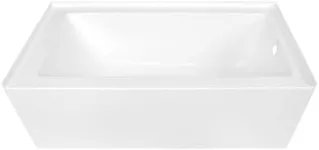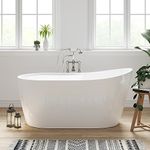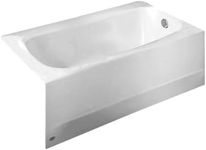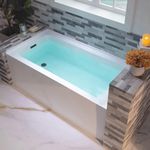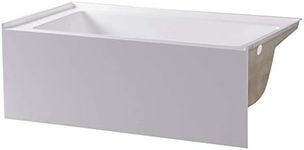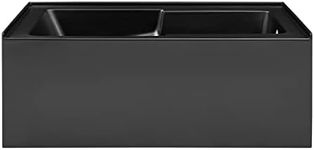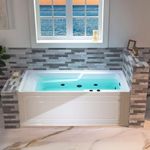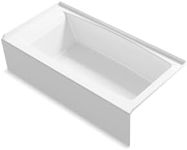Buying Guide for the Best 60-Inch Bathtubs
Choosing the right 60-inch bathtub involves considering several key specifications to ensure it meets your needs and preferences. A bathtub is a significant investment, and it's essential to select one that provides comfort, fits your bathroom space, and aligns with your style. Here are the key specs to consider when picking a 60-inch bathtub and how to navigate them to find the best fit for you.MaterialThe material of the bathtub affects its durability, weight, and heat retention. Common materials include acrylic, fiberglass, cast iron, and porcelain. Acrylic and fiberglass are lightweight and easy to install, making them popular choices for many homeowners. Cast iron and porcelain are heavier but offer excellent durability and heat retention, keeping your bath water warmer for longer. If you prefer a lightweight and easy-to-maintain option, acrylic or fiberglass might be best. For a more luxurious and long-lasting option, consider cast iron or porcelain.
StyleBathtubs come in various styles, such as alcove, freestanding, drop-in, and corner. Alcove tubs are installed in a three-wall enclosure and are ideal for smaller bathrooms. Freestanding tubs are standalone units that can be placed anywhere in the bathroom, offering a stylish and modern look. Drop-in tubs are installed into a pre-built deck or platform, providing a seamless appearance. Corner tubs are designed to fit into a corner, saving space and adding a unique touch. Choose a style that complements your bathroom layout and meets your aesthetic preferences.
Depth and CapacityThe depth and capacity of the bathtub determine how much water it can hold and how immersive your bathing experience will be. Standard bathtubs typically have a depth of 14-20 inches, while deeper soaking tubs can go up to 22 inches or more. If you enjoy long, relaxing baths, a deeper tub with a higher water capacity will be more suitable. For quick showers or if you have mobility issues, a standard depth might be more practical.
InstallationThe installation process varies depending on the type of bathtub you choose. Alcove and drop-in tubs require more complex installation, often involving plumbing and carpentry work. Freestanding tubs are generally easier to install but may require additional floor reinforcement due to their weight. Consider your DIY skills and whether you will need professional help for installation. Ensure that the installation process aligns with your bathroom's existing plumbing and layout.
FeaturesModern bathtubs come with various features such as whirlpool jets, air baths, built-in heaters, and ergonomic designs. Whirlpool jets provide a massaging effect, ideal for relaxation and muscle relief. Air baths use air jets to create a gentle, effervescent experience. Built-in heaters maintain water temperature, allowing for longer, more comfortable baths. Ergonomic designs offer better support and comfort. Determine which features are essential for your bathing experience and choose a bathtub that includes those options.
Finish and ColorThe finish and color of the bathtub can significantly impact the overall look of your bathroom. Common finishes include glossy, matte, and textured surfaces. Glossy finishes are easy to clean and maintain, while matte finishes offer a more contemporary look. Textured surfaces provide better grip and safety. Bathtubs are available in various colors, from classic white to bold, modern hues. Choose a finish and color that complements your bathroom decor and personal style.
